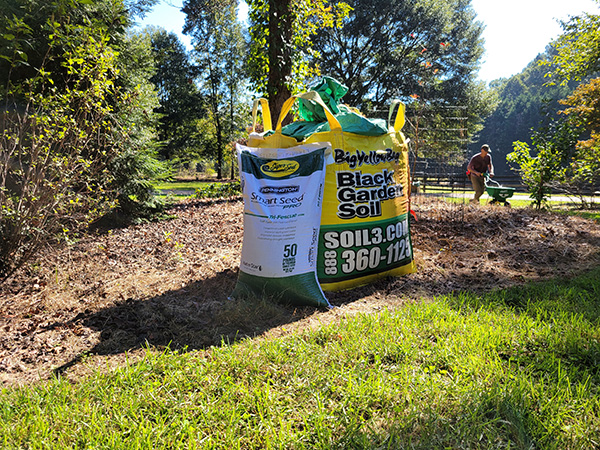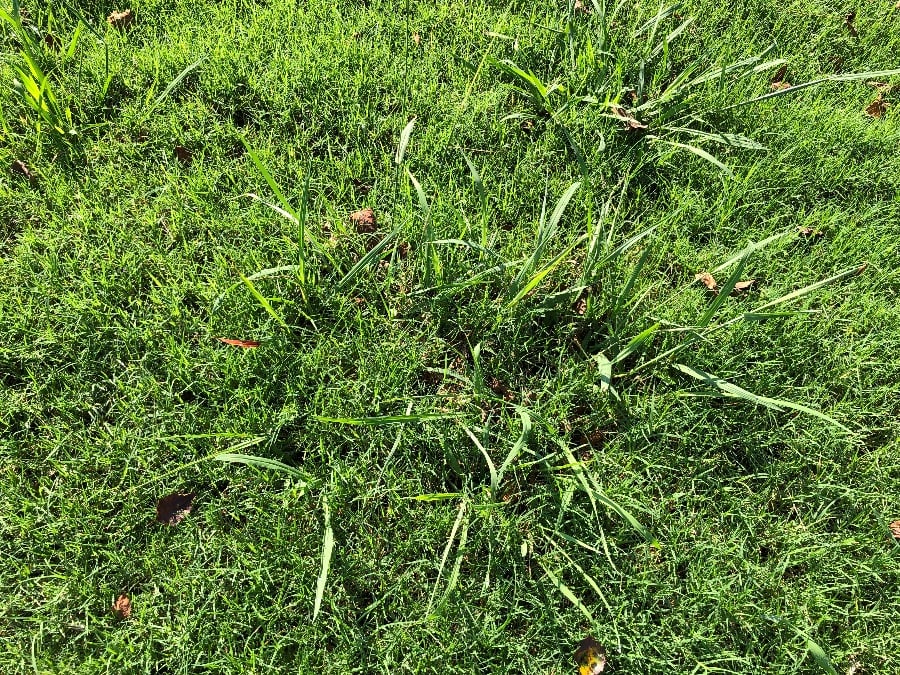

Whew! It's been hot and Tall Fescue did not love it. Finally the searing temperatures are cooling off and it looks like the extreme heat has broken here in the Southeast. I think it's safe to say that now that it's September, let's shift gears because it's Tall Fescue Time!
September begins Tall Fescue season in cooler regions, with the height of overseeding season rolling along through October.
For the glorious Tall Fescue lawn of your dreams, we recommend overseeding with fresh seed every fall.
- Prepare for overseeding Tall Fescue by cleaning up your lawn and spraying out weeds. This way, you'll have that task taken care of well before planting season is over and it won't be a last-minute problem to solve.
- Caution: If you plan to plant Tall Fescue seed, don't apply a pre-emergent herbicide in the fall (skip the September/October application).
- Order your Tall Fescue seed online or in person by calling or dropping by a store.
Fall Armyworm Alert
Besides heat and drought, these creepy crawlies are the biggest threat to the health of your Tall Fescue lawn. Tall Fescue lawns are food of choice for fall armyworms, so we recommend preventative insecticide (5-10-30 with Acelepryn) for new and established Tall Fescue lawns.
These caterpillars (not technically "worms") are a possible infestation until frost. Learn the signs, scout daily, and act quickly if you see them. >>Read up on fall armyworms
You Still Need Fungicide on Tall Fescue
- Systemic protection of the whole plant: Both modes of action are systemic, meaning they work from the inside of the plant to protect the entire plant. What's found at most big box stores is contact only.
- It goes further: One bag will cover multiple applications for the average-sized lawn.
- Pro-grade: Used by golf courses and we use it in our sod production.
Behold! A verdant Tall Fescue lawn in August, because it received monthly Strobe G fungicide all summer. It's as lush as springtime! Sent to us by a Lawn Coach customer in Charlotte, NC.
How to Water Your Tall Fescue Lawn
💧 Established Tall Fescue lawns like 2" of water a week during the heat of summer.
💧 After your new sod or newly overseeded lawn is rooted in, you'll be able to back off watering to 1" per week during the cool months.
Water your lawn in the morning: Why the fuss? Water sitting overnight on leaves promotes diseases. When you water in the morning, moisture rapidly dries from the leaf blades when the sun is out. If you water in the evenings, moisture may not evaporate from the leaves until the next day. Watering in the evenings promotes diseases.
Insecticide & Fertilizer Tips
- 🐛 To prevent fall armyworms and feed your lawn, we recommend our 5-10-30 with Acelepryn insecticide for Tall Fescue. It's safely low in nitrogen and the phosphorus and potassium will benefit overall health. Don't fertilize with high nitrogen until it cools off and your Tall Fescue begins active growth.
👍 Real World Example: Don't use 16-4-8 fertilizers during warm/hot summer months. The 16 represents the amount of nitrogen. It's okay to use a low nitrogen fertilizer such as 5-10-30 wtih Acelepryn. - 🐛 Fall armyworms adore tender, new sod that has recently been installed. Fescue is especially vulnerable because it's not a spreader and doesn't have the ability to repair itself like Bermuda and Zoysia does. If you've recently laid Tall Fescue sod, we highly recommend spreading 5-10-30 + Acelepryn as insurance. It lasts 30-45 days, depending on weather conditions, so keep in mind that you may need to reapply it once more this summer.
- When temperatures really cool off (this month? next month?) it will be high time to fertilize with more nitrogen, such as our 16-4-8 or 18-24-12.
- Review the fertilizing schedule in our Tall Fescue Maintenance Guide.
- Sign up for Lawn Coach and we'll automatically mail you all the right fertilizers when you need them (including the fungicide when you select the Champ package).
- Even though it's not a good time to fertilize with nitrogen, it's still okay to apply fast-acting lime if you need to neutralize the pH of your soil. Always take a soil test to confirm if you need to apply lime or fertilizer. Balanced soil pH is critical for your grass to be able to use the nutrients supplied by your fertilizer.
Weeding Tips
- Pre-emergent herbicide: If you're not starting a new lawn from seed, the window for applying pre-emergent herbicide is open from September 15th through October 15th. Pre-emergent will prevent winter weed seeds from rooting. It kills off the first root that comes out of the seed and you'll never see the rest of the weed germinate.
👍 Rule of Thumb #1: Don't apply pre-emergent if you plan on reseeding a Tall Fescue lawn. How come? The pre-emergent will also inhibit your Tall Fescue seeds from germinating. Skip fall pre-emergent and wait until the February application.
👍 Rule of Thumb #2: Don't apply pre-emergent to new sod because it will also inhibit your new lawn from rooting. It's safe to apply pre-emergent to Tall Fescue lawns when it's 4 months old. - For weeds you see now, apply post-emergent liquid herbicides. Read the label and follow instructions.
👍 Rule of Thumb: It's ok to apply a post-emergent after you've mowed a new lawn 3 to 4 times. - Pulling by Hand: September offers lovely temperatures for being outside and pulling weeds. I enjoy listening to college football games, and I find that pulling weeds while listening to my team serves as a therapeutic counterbalance to the game's stress.
- Mowing: Mow those weeds down before they go to seed. Mowing is an effective way to suppress weeds because it cuts off flower/seed heads and that stops weeds from making more weeds, thus breaking the life cycle. If you have bad weeds, mow on a weekly routine and don't let the weeds get ahead of you.
- Mulch suppresses weed seeds in flower beds. Spread your favorite mulch 2-4" thick and keep it 1-2" away from touching the trunks or stems of your plants.
- Dallisgrass is one of the rare perennial grassy weeds that infests lawns. You will need a shovel to attack this monster. Read how to get rid of it in your lawn and flower beds: September Weed of the Month: Dallisgrass
This is classic Dallisgrass behavior: to thoroughly embed itself in your lawn, but leave an open center so the lawn grows through it.
Mowing Tips
Mowing Height: It's not time to lower the mowing height on Tall Fescue; that will happen when it cools off. Continue to mow at the higher 3 to 4" cut height through September. We'll remind you (next month in October) when it's time to lower the height back down to 2.5 to 3" for the duration of the cool months ahead.
Mowing Frequency: We recommend mowing every 5 to 7 days when Tall Fescue is actively growing. Here's what it might look like during various times of year:
- Spring: You should mow once-a-week during rapid growth.
- Summer: During the hot days of summer, your Tall Fescue lawn slows down, so you probably needed to mow less frequently - possibly every other week.
- Fall: You will pick up mowing frequency this fall as your freshly reseeded lawn kicks into gear.
- Winter: Mowing frequency will vary; you'll mow less often during December and January when there's less sunlight and the temperatures are frigid, but remember to mow more frequently in February as day length increases and there are random warmer weeks.
Laying Sod & Planting Seed
To successfully plant Tall Fescue seed and sod, look for a weather pattern with cooler days and crisper nights. You can go ahead and order your Tall Fescue seed now so it's on hand when you're ready.
For tips on what to do for Warm Season lawns such as Bermuda, Centipede, Zoysia, peruse this page: September Warm Season Lawn Tips.
Questions? Leave a comment below!
Come back next month for October's Tips for Tall Fescue lawns.
If you're new here, subscribe to our emails to get this information in your inbox every month.






